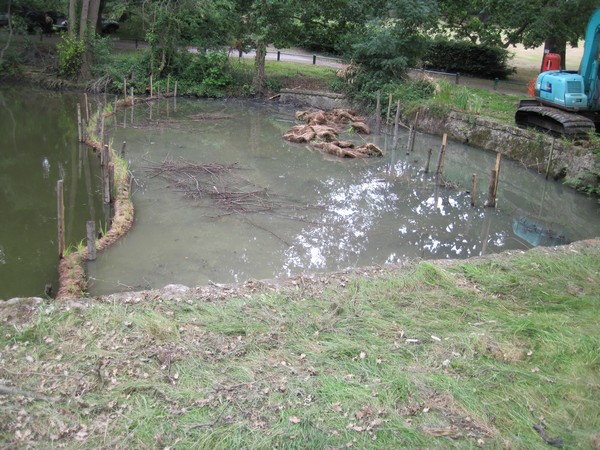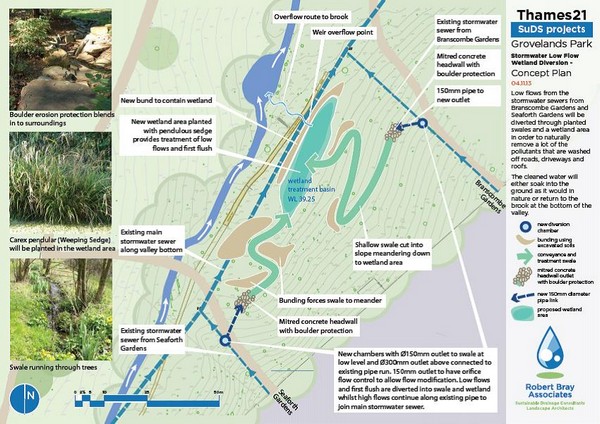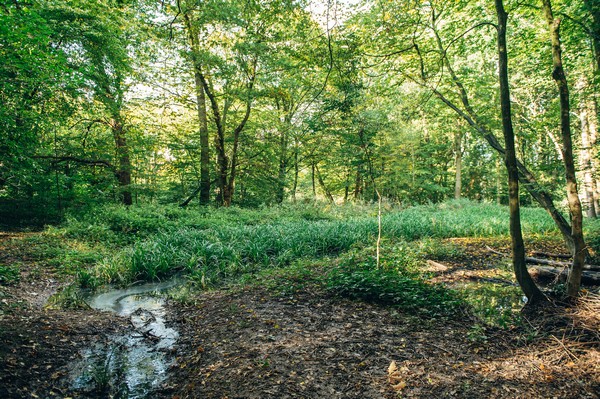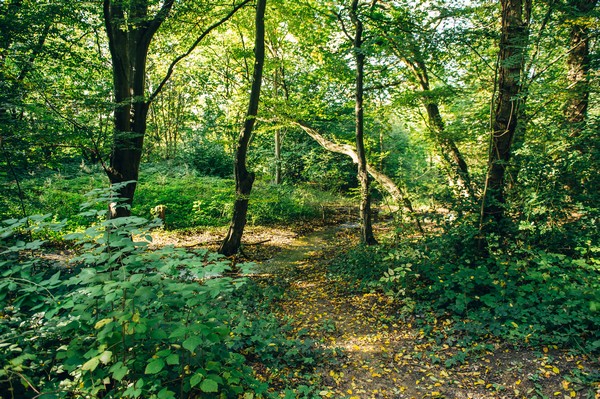Where
Description
This project was undertaken as part of the Salmons Brook Healthy River Challenge, an initiative designed to improve water quality in the Salmons Brook and its tributaries by tackling urban diffuse pollution. Enfield has a predominantly separate sewage system, meaning that surface water and wastewater are carried in two separate pipes. However, pollutants can enter the surface water network, and subsequently watercourses in a number of different ways. Misconnected plumbing contributes phosphates, nitrates and coliform bacteria etc., road run-off inputs oils and heavy metals such as zinc and copper, and household and industrial waste is dumped into surface water drains. This pollution is particularly evident during dry periods when there is little rain to dilute misconnection flows.
As part of this project we undertook a series of measures to improve water quality and re-naturalise the water system in Grovelands Park.
The Grovelands Park Wetlands are set in a wooded area of the park and receive surface water from an urban catchment of approximately 11ha which is primarily residential with pockets of commercial land use. The wetlands intercept and treat this water before discharging it to a nearby stream, 320m of which was daylighted as part of this project. The stream is a tributary of the Houndsden Gutter which itself is a tributary of the Salmons Brook.
As part of the wetland creation and stream restoration a reedbed was created in the lake to intercept pollution from another surface water sewer. The wetland also provides flood risk reduction by attenuating flows and reducing the volume of surface water.
SuDS components used
- Wetlands
- Swales
To create the wetland basin system two surface water sewers were intercepted. Day to day low flows and the first flush (the most polluted water during a rainfall event) are brought through planted swales into a wetland basin for treatment. Plants reduce the amount of nutrients within the water and stop them polluting the stream (See figure 1 construction). Bacteria in the soil and root systems break down oils and heavy metals within the water.
 |
| Figure 1. Reedbed construction |
Water then infiltrates into the soil or, during prolonged wet weather, the basin will fill and overtop a weir to discharge to the stream at the bottom of the valley.
During high flows a large proportion of the water will continue to flow in the surface water sewers and discharge into the main sewer which previously contained the stream (before it was daylighted during this project). This prevents excessive erosion and flooding in the wetland.
Two parallel surface water sewers taking runoff from local streets were intercepted and a new chamber was added to each sewer with an additional 150mm pipe to feed the SuDS scheme. This pipe discharges through a concrete headwall with boulders inset to slow flow and prevent erosion at the start of the swales. The shallow swales meander through trees avoiding root damage and discharge to the wetland basin. The basin was excavated in a naturally low area with spoil used to form a bund alongside the adjacent footpath. The wetland was initially planted with pendulous sedge and later with wetland edge mix species. A concrete weir, with boulders downstream to dissipate flows, allows overflow along a short length of swale fanning out into the daylighted stream.
A new length of boardwalk was created to allow better access to the wetland and interpretation is to be created for this site in winter 2016. The project has been developed in consultation with the community and the active Friends of Grovelands Park, as well as additional engagement for volunteer planting days, pollution prevention and misconnection advice and family fun days centring on wetland and aquatic wildlife. See figure 2 for the concept and context of the scheme.
 |
| Figure 2. Concept and context of the scheme |
Maintenance & operation
The swales and wetland basins that collect and treat polluted runoff are very similar to naturally occurring wetlands and are maintained in the same way. This is the responsibility of Thames21 who have worked with dedicated local volunteers to establish and control vegetation and clear litter when necessary.
Checks must be undertaken to ensure that the new chambers in the surface water sewers are functioning correctly and ensure outlets do not become blocked. The London Borough of Enfield (LBE) has agreed to take on the long term structural maintenance of the system, making it a sustainable public asset.
Local residents, Thames21 staff and volunteers also check the stream, wetland and lake for pollution incidents and report these to the Environment Agency and Thames Water.
Monitoring & evaluation
The initial aim of the project was to improve water quality and therefore a comprehensive programme of water quality monitoring has been undertaken. Samples were taken from the swales and where possible below the wetlands. Samples were also gathered from above and below the lake reedbed. Most analysis was carried out in Thames21’s own lab facilities, and as far as possible on a fortnightly basis. Temperature, pH, conductivity, dissolved oxygen, total nitrogen, nitrates, ammonia, phosphates and coliforms were measured. Results were analysed by qualified staff at Thames21, and verified by sending samples to accredited laboratories. Full reports are available on request to Thames21.
Citizen scientists have been trained to test water quality and report pollution, and further free training is available to anyone who is interested in helping maintain the wetlands.
Benefits
The creation of a wetland basin has improved water quality and provided a new habitat feature, with the daylighted stream and reedbed also attracting associated wildlife.
During all but the highest flows, the wetland basin captured all polluted water, treated it and slowly released it into groundwater instead of the local stream, indicating almost total effectiveness in preventing pollutants entering the stream. Pollution incidents can be easily identified and dealt with if they do occur.
Social benefits included improved landscape giving attractive new features and reduced flood risk associated with stream daylighting (see figures 3 and 4).
 |
| Figure 3. Completed scheme |
 |
| Figure 4. Completed scheme |
Although not part of the SuDS, it may be of interest that water sampled immediately after the reedbed was significantly cleaner than water sampled before it. There was a 55.3% reduction in total nitrogen, 36.8% reduction in ammonia and 68.7% reduction in nitrate concentrations entering the lake.
Lessons learnt
Establishing sedges in the swales proved difficult due to the shaded conditions and higher flows at times. Once the sedges has established in the wetland basin (2 years after planting) we transplanted them into the swales where they are now thriving.
Levels of pollution here were higher than expected, with obvious sewage related litter appearing in the swales at times, impacting on the acceptance of the scheme in the local community. Working closely with the Thames Water misconnections team was key to solving this issue as the misconnections were rectified. These urban catchments face big issues with plumbing misconnections. Solving these misconnections was an added benefit of the scheme.
Liaison with Thames Water to install new chambers in the surface water sewers was not a difficult process but increased the lead-in time before construction began.
Interaction with the local authority
This was a joint project with the London Borough of Enfield. As landowners they chose contractors and led on the implementation of the wetland system and stream daylighted, as well as flood defences. They also provided funding for the project. Support was also given for public engagement through the Parks department.
Project details
Constructions costs for wetland: £40,000
Construction costs for daylighting stream £30,000 and associated flood defence £60,000
Construction costs for reedbed: £15,000
Planning began in September 2012.
Construction and planting of the wetland system took place in summer 2014, with the system becoming operational in autumn 2014.
The reedbed was created in July 2015.
Successful re-planting of the swales with sedges transplanted from the basin took place in summer 2016.
Project partners (and funders)
The London Borough of Enfield (LBE) are key partners steering the project, the land owner and provided funding
Defra provided significant funding
The Environment Agency provided support
Thames Water (support and funding for latter parts of the project)
Thames21
Project team
Project management and engagement: Thames21.
Landscape architect: Robert Bray Associates
Wetland system and stream restoration: AH Nicholls
Reedbed constructed by Aquamaintain
Maintenance: Thames21 working with local volunteers



